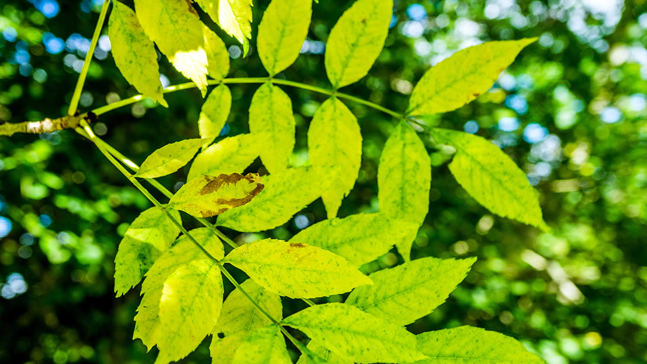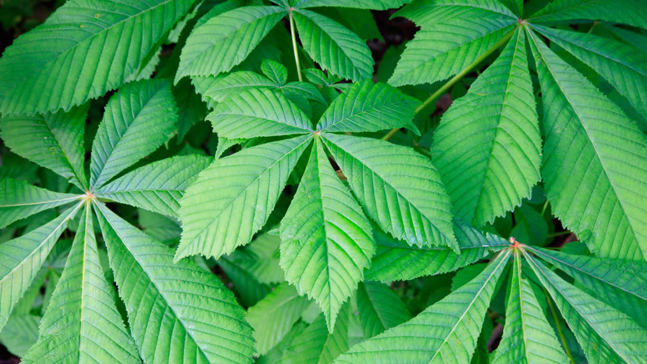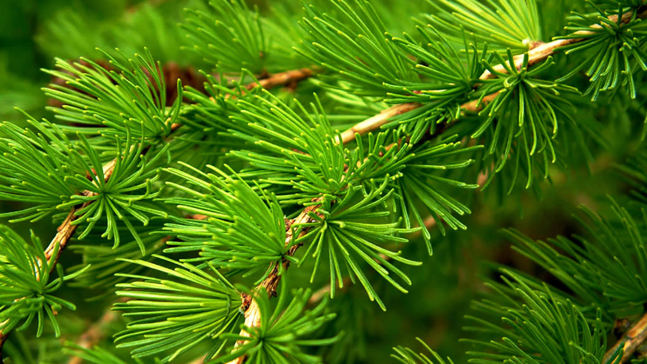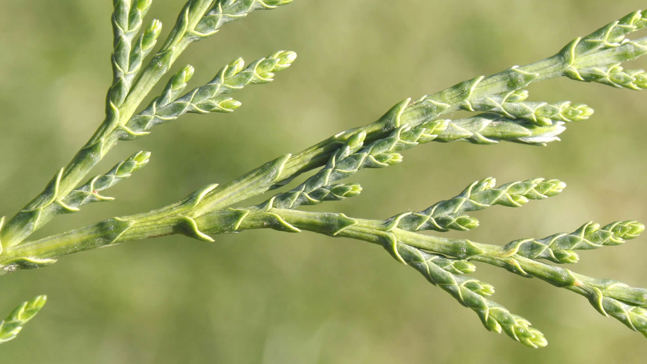
All trees have clues and features that can help with identification. You just need to know what to look out for. This quick guide to tree identification will give you a few basic hints and tips.
Learn how to identify trees with our top tips on what to look out for.
Credit: Michael Heffernan / WTML
The UK has at least fifty species of native trees and shrubs, and many more species of introduced non-native trees.
There are lots of features that give you clues to what species it is.
Get an A-Z guide of trees by downloading our free tree ID app for Android and iOS.
Some trees have a distinctive look that can be used to identify them, especially from a distance.
Compare a silver birch, with its narrow shape and light and airy crown, to the broadly spreading crown of an oak.
Overall shape is also useful when identifying conifers. The layers of horizontally spreading branches of a mature cedar of Lebanon contrast with the sparsely branched Scot’s pine or densely bushy yew.
Look for signs of management which can affect the shape. Trees like hazel, hornbeam, beech and willow may have been coppiced or pollarded which can create a tree with many stems, rather than a tall, single trunk.
The location of a tree affects its appearance and shape. Trees in woodland often have narrower crowns compared to trees in parks with lots of space around them.
The distinctive branches of ash trees curve down towards the ground, then turn upwards at the tips.
Credit: Colin Underhill / Alamy Stock Photo
The branches of cedar of Lebanon grow in horizontal layers.
Credit: naturepl.com / WTML
Look out for the towering, straight trunk of Scots pine.
Credit: Geoff Hall / WTML
Some species, like hornbeam, may be cut at the base known as coppicing which produces a tree with several stems rather than a single trunk.
Credit: Robert Read / WTML
Take a closer look at the appearance, texture, markings and colour of the bark.
L ook at the bark all the way up the tree as it can vary between the base and the crown.
The bark of ash is pale brown to grey, with fissures as the tree matures.
Credit: Derek Mcginn / WTML
Cherry bark is a deep reddish-brown colour with prominent horizontal lines.
Credit: Nature Photographers Ltd / WTML
The white bark of silver birch sheds in layers like tissue paper and becomes black and rugged at the base.
Credit: John Bridges / WTML
The silvery-brown bark of sessile oak becomes rugged and deeply fissured with age.
Credit: David Mason / WTML
The bark of apple trees is typically grey in colour with bumps, scales or ridges.
Credit: Lesley Newcombe / WTML
Leaf type, shape, appearance, texture and colour are all key characteristics when identifying trees.
They are also often the most obvious feature, particularly in spring and summer. The needles and scales of conifers are also considered types of leaves.
The leaves of broadleaved trees fall into two basic types - simple and compound.

Credit: Philippe Clement / naturepl.com
Simple leavesLeaves are whole and are not divided right to the central leaf vein, such as apple or birch. The edges of some simple leaves can be indented or lobed, such as sycamore, field maple and hawthorn, so take care not to mistake these for compound leaves. Lime leaves are a simple and heart-shaped leaf with a pointed tip.

Credit: WTML / Ben Lee
Compound leaves - pinnateCompound leaves fall into one of two categories - pinnate and palmate.
Pinnate are feather-shaped where leaflets are attached in pairs along the central vein such as rowan, ash and elder.

Credit: Christine Whitehead / Alamy Stock Photo
Compound leaves - palmateThese are palm-shaped, like the outstretched fingers of a hand. Horse chestnut has palmately compound leaves. Be careful not to mistake Acer species such as sycamore and field maple as having palmately compound leaves - they are actually simple with a lobed margin.
Take notice of the colour, texture and edges of leaves (do they have serrations?).
In autumn, some species have leaves that turn spectacular autumn colours. Guelder rose and field maple often turn a vivid orange or red.
Trees that are closely related often share similar features. All elm species have unequal leaf bases - take a look at the bottom of the leaf where it meets the leaf stem (known as a petiole)..
Credit: WTML / Anna Badley
Aspen have very rounded (orbicular) leaves.
Credit: WTML / Daniel Romani
The leaves of downy birch are triangular (deltoid). Other birches, like silver birch, also have leaves that are this shape.
Credit: WTML / David Nash
Several willows, like this white willow, have long, thin (lanceolate) leaves.
Credit: WILDLIFE Gmbh / Alamy Stock Photo
Look out for leaf edges that are lobed like this hawthorn. Oaks, sycamore and maples also have lobed leaves.
Credit: WTML / Ben Lee
The leaf edges of beech are wavy. This is one way to tell the difference between beech and hornbeam (which have serrated leaf edges).
Credit: WTML / Ben Lee
Hornbeam leaves have serrated (toothed) edges.
Credit: Deborah Morris / WTML
Box leaves are egg-shaped (ovate).
Credit: Alex Caswell / WTML
If the foliage on the tree is needles or scales then you are probably looking at a conifer. These include trees in the pine, fir, cypress, larch and spruce families.
Most conifer trees have needles or scales present all year that can be used for identification. One of the few exceptions is European larch which loses its needles in winter.
Conifers can be separated into two broad groups.

Credit: WTML / Margaret Barton
Pines, spruces, firs, cedars and larches have needles. They can be different shapes, sizes and be arranged differently on twigs. Flattened needles could mean a yew or whorls of three needles juniper.
Larch needles are arranged in clusters.

Credit: FLPA / Alamy Stock Photo
Species of the cypress family have scales. These are flattened and shield-shaped that overlap on the twig.
Leaves and needles are often the most useful clues for identifying trees. Look closely at the type, shape, edges and arrangement of them.
Many trees only bloom at a particular time during the year but if you can see flowers, usually in the spring, it can be another helpful to help with tree identification.
Broadleaf trees have flowers that contain the reproductive organs, and most conifers have cones for reproduction. Here are some basic types.
What time of year is the tree flowering? Blackthorn blooms in late winter, before the leaves have come out. But hawthorn flowers much later on in May, once its leaves are out.
Ash flowers are by no means showy, but they are an unmistakable deep purple colour. The flowers appear before the leaves have emerged.
Credit: Brian Hird / Alamy Stock Photo
Bird cherry flowers are clustered together in spikes (known as racemes) at the ends of the shoots.
Credit: Bob Gibbons / Alamy Stock Photo
Male and female flowers can look very different. The make flowers of hazel hang in long catkins, but the female flowers are tiny with their shocking pink stigmas peeping out of the top like tiny sea anemones.
Credit: Ross Hoddinott / naturepl.com
Cherry plum tends to flower very early - before the winter is out. Its flowers grow singly, rather than in clusters.
Credit: Christine Whitehead / Alamy Stock Photo
Another early flowering tree. Blackthorn blossom appears in late winter or early spring, long before its leaves unfold. Its frothy white blooms stand out against the wintry hedgerow.
Credit: John Richmond / Alamy Stock Photo
Male alder catkins are long and dark green whereas female catkins are small and egg-shaped. These female catkins will eventually develop into the woody 'cones' that holds the seeds.
Credit: Nature Photographers Ltd / WTML
At the right time of year fruits and seeds are a great character to help with identification. They vary in shape, appearance and size from hard nuts to soft berries.
Look at the colour and feel the texture of the outer surface of the fruit. Is it smooth, hairy, prickly, rough or papery, soft, hard or dry?
Consider opening fruits up to reveal the seeds inside, which can also be a useful identifying feature. Take note of whether fruits or seeds appear singly, such as crab apples, or in groups like the umbrella-like clusters of elderberries.
The fruit types of broadleaf trees vary greatly and include samaras, nuts, catkins, berries, stone fruits, apples or pears, capsules and cones.
Samaras are papery, winged fruits. Their 'wings' can be in pairs (field maple and sycamore) or single (hornbeam, ash).
Credit: Ben Lee / WTML
Nuts are usually dry and woody. Some are unmistakeable such as the shiny brown sweet chestnuts.
Credit: Wendy Johnson / Alamy Stock Photo
Catkins are long and dangly and becoming fluffy masses of seeds in summer (willows and birches).
Credit: Frank Hecker / Alamy Stock Photo
Berries are soft and juicy fruits often containing several seeds (elder and guelder rose).
Credit: Ben Lee / WTML
Stone fruits have a fleshy exterior and a single stone inside (plums, cherries and sloes).
Credit: Blickwinkel / Alamy Stock Photo
Apples or pears are larger fleshy fruits with many seeds inside (crab apple, Plymouth pear).
Credit: Frank Hecker / Alamy Stock Photo
Capsules are seeds contained within capsules of varying shapes and colours like the bright pink capsules of spindle which split open to reveal bright orange seeds.
Credit: Nature Photographers Ltd / WTML
Cones - alder has fruits that look like dry, woody cones that remain on the tree all year.
Credit: WTML / Nature Photographers Ltd